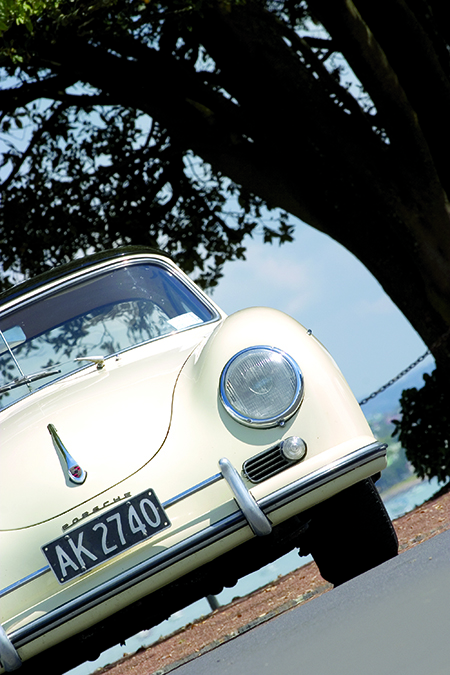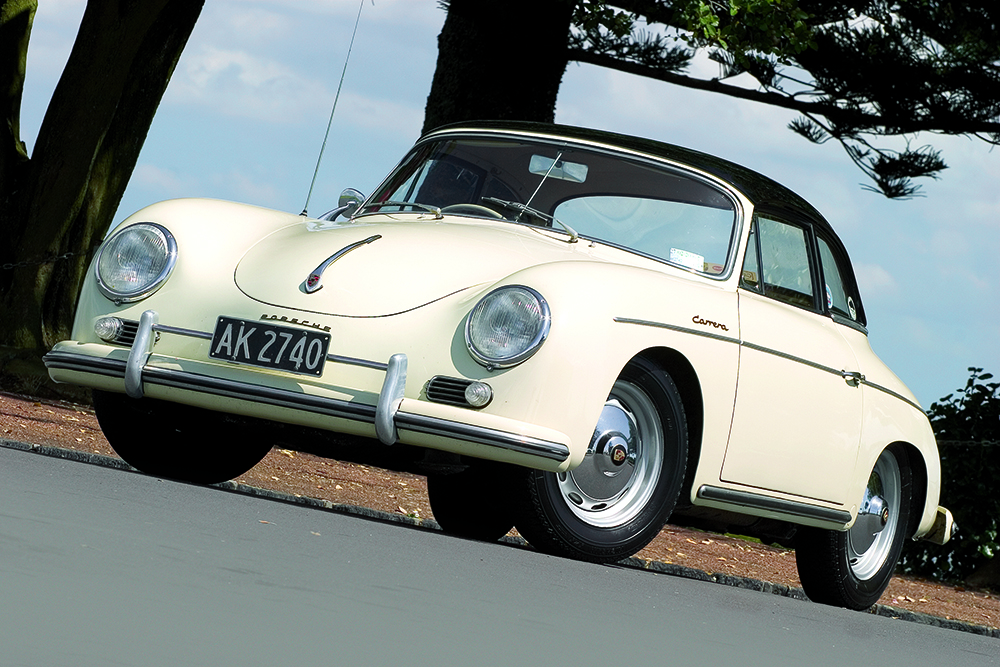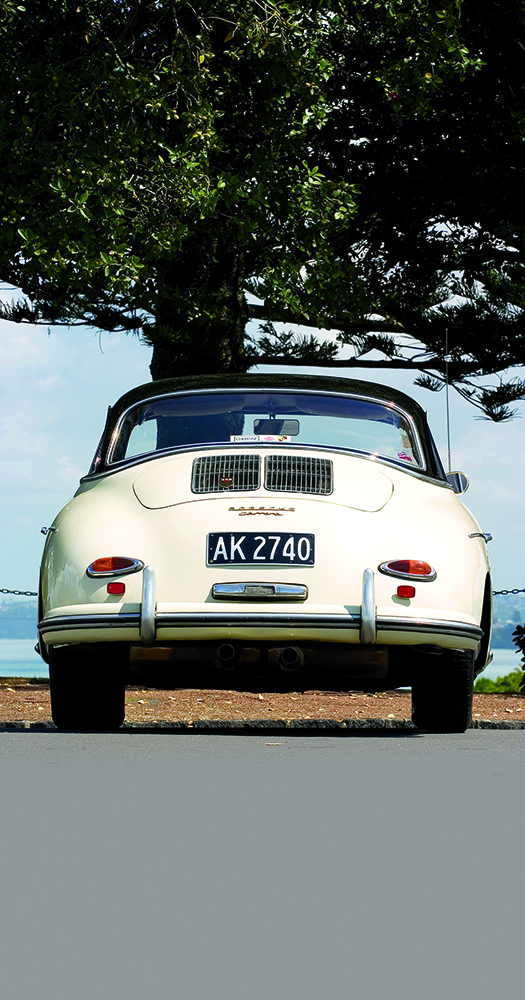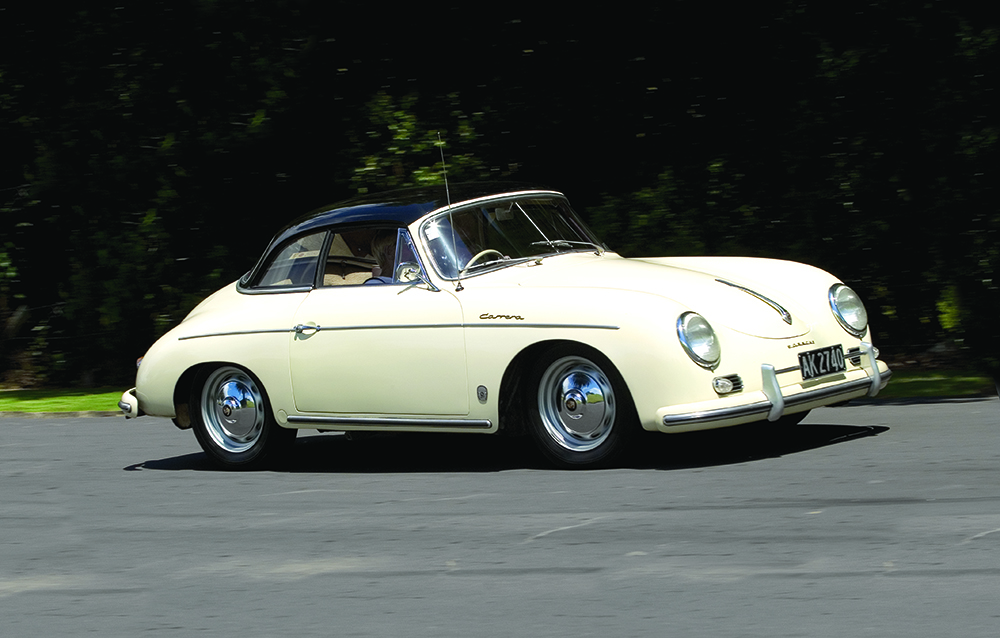data-animation-override>
“Published in New Zealand Classic Car Issue No. 173”

I’ll never forget my first drive in a Porsche. It came during my early months in the motor noting business; I was to photograph motoring journalist Brian Cowan hurling the first 911 996 in NZ around a bit of local scenery. But on picking the car up he asked the then boss at European Motor Distributors, the Porsche importer, if I could have a drive. Trevor Hudson was an enthusiast first; a businessman second. He didn’t bat an eyelid.
Thus my first Porsche was a left-hand-drive 996, on unfamiliar roads, with a madman in the passenger seat telling me to follow his instructions exactly. He did know the roads, and had a pretty good idea of the car’s capability. “Third!” he barked. “Flat! Lift! Second! Flat! Veers left over brow! For God’s sake woman, put your foot in it!” And I did. Heart in mouth, too busy to register my life flashing before my eyes. Tyres chirping, that fantastic engine shoving me in the back with each lurid prod at the throttle; hovering on the knife edge of control, Cowan laughing delightedly at my introduction to driving Nirvana. I was hooked. And it was thanks to Hudson’s conviction that enthusiasm should be nurtured.
Fast forward seven or eight years
Hudson’s retired; but he’s still an enthusiast. His retirement car of choice is the only Porsche Carrera 356 in the country. Actually it was bought as an investment 18 years ago together with then boss, Colin Giltrap. Giltrap might be the consummate businessman, but he’s also a petrol-head. “It’s co-owned,” Hudson says with a smile, “But I’ve got custody, and I maintain and run it.”
And it certainly is run. When he retired Hudson celebrated by taking a 6500km south-island odyssey in the car, travelling south via a few fairly challenging roads. “The first day we went from Auckland to Taumurunui, then Whangamomona. The pub was junk back then!” But not the Carrera. “It’s good on gravel — the tyres are very narrow, and cut in.”
Waikaremoana seems to strike a spark in 356 owners — perhaps their passion makes them link their piece of history with this historic road. One of Minister of Parliament Harry Duynhoven’s first long drives in his 356, the oldest in NZ, was over the same road, “About 30 years ago, not long after I bought it.” That Hudson has barely had to touch his Carrera since he purchased it doesn’t surprise Duynhoven. Meeting me at an industry event and asking that standard ‘driven anything interesting lately’ question, he lit up when told I’d been in Hudson’s car just hours previously.
“The first time I came across his car was I think in 1978, when I’d finally restored — or refurbished — my 1953 356 to a moderately presentable state. I was tracking down another early Porsche, and the owner of that said ‘do you know about the Carrera?’” Duynhoven chuckles; “Of course I didn’t, but I went to see it and it was owned by a wonderful enthusiast, Gordon Voghterr, in Hastings.
“There was this Carrera, in beautiful condition. His father had owned it from new and sold it, and he’d bought it back many years later. It was in stunning condition, just stunning, an original car in beautiful condition, as opposed to mine! Mine was pretty scruffy when I bought it, and I’d really just tidied it up.”
Was he tempted to buy it?
“No, I just wanted to drool over it really, it was a beautiful early Porsche, and when I found there was an early 356 car in NZ I had to see it, it was just so rare.”
Duynhoven didn’t get to drive it and is clearly jealous; the first, and probably the last time a Minister of the Crown will ever covet one of my achievements.
“Gordon did fire it up and drove it out of the garage, but it wasn’t warranted or something, we didn’t go for a drive in it. I saw it again just recently at the Tongariro 356 gathering, and it looked as pristine as it did 25 years ago.”
Duynhoven was there as he’s still got a couple of 356s.
Six volter
Hudson’s car is still in good nick. I’m trying to find out what he’s done to it, but it’s very little — and he’s not aware of many changes since it was new. “I think a section of the carpet is new, there’s a slight variation in the colour; but it hasn’t been touched in the time we’ve had the car.” He thinks the headrests were after market. “They’re bulky, clumsy things and I won’t use them — not just because they don’t look right, they’re uncomfortable and they fill the cabin too much, and make vision to the rear difficult.”
The radio’s ‘new’ — “Blaupunkt found this in Invercargill,” — but the Carrera still runs on six volts. “A lot of people change the six volt cars to 12, and while that’s quite good I was keen to retain the car with its original spec.” Really the only departure is the fire extinguisher bolted under the driver-side dash. The seats are covered in the original red leather, which has gained a glowing patina where decades of backs and bottoms have rubbed it. The overall effect of the creamy paint, the gleaming black roof, those lovely curves and inside, the glowing red and cream — this car has presence.
How far has it travelled? “It’s showing 98,000 miles (157,711km); when I got it the distance recorder wasn’t accurate. I had it recalibrated with new cables and things, so I’m not sure what it’s done in total, but it’ll have done at least 32,000km since we had it — not a great deal when you think how long that is.” As we walk around the car we admire the details that separate this 356 from the rest of the breed.
“This one doesn’t have disc brakes,” Hudson points out, “It’s the last of the drum — but being a Carrera, just look at the size of the brakes! The drum’s almost the diameter of the wheel. They all went to disc in about 1961.” Are these tyres originals? “They’re Michelins; they’re still available new.” And what’s the flattened black pipe tucked beneath the rear bumper? “The car has a quite unique heater. It’s petrol fired! I don’t use it for safety reasons, though it was standard fitment from new.”
And the roof? “I don’t take it off because it’s so good — it doesn’t rattle, it doesn’t leak, and you’d have to be confident it wouldn’t rain when you were out. Not all the Carreras had the removable hard-top. In fact it’s one of the unique features of this car — only one 1958 RHD four-cam engined-Carrera was manufactured with the removable hard top. Any other four-cam cars built that year weren’t RHD, or with the hard top.”
Already someone’s come up to ask about the car — a constant hazard when trying to photograph a beautiful classic. But this time’s a bit different, for Ian Goldingham has seen it before. His dad was the secretary for Joe Gardner, and he remembers going to the bach in Taupo, “Doing 120mph (193kph) in this car; I was about seven at the time!”
Clearly it’s a valued memory and he recalls a sister car to this one, in a pale powder blue. “Jo Gardner had a showroom on Broadway, roughly where the Nissan showroom is now. I know Jo quite well, and Alex Stringer who drove a car for Jo and raced at Levin. He didn’t drive this car so much — he drove an ordinary 356.”
A life with cars
As our photographer gets to work, Trevor used the time to reminisce. “At EMD [European Motor Distributors] I represented Porsche, Audi, VW, Rolls-Royce, Bentley, and Aston Martin, which gave me variety. But I started out in 1947 with Austin. “I left school the day the polio epidemic closed the school. I went home to lunch and my dad, Vic, said okay, you’d better go to work. So after lunch I did, I went to work pumping petrol at Hudson Burnham, the Austin agency. “I’ve got a lovely photo of a 1929 Austin I owned.”
Trevor had never owned a Porsche before this one — though of course he drove them when he started as managing director of EMD in 1980. Then Ray Barker, a loyal customer, decided to rear
range the cars in his business and this became available. “We’d indicated an interest, so we bought it to ensure it remained in New Zealand. Though I didn’t do an extended trip in it until that retirement holiday — when we didn’t use the luggage!” Trevor’s referring to the three, custom-made, tartan-lined leather suitcases that fit the rear shelf when seatback’s folded down. But over the years they’ve developed a peculiarly pungent smell. The story of his attempts to get rid of an odour that permeates any clothes packed in the cases would fill several pages in itself.
Drive time
Lid up, we admire the very tidy engine — and so it should be. “I sent it to the Porsche factory in Germany in ’98, and it was rebuilt. It’s a very complex engine; few people have access to spare parts and no-one in NZ had a great deal of experience with it. Porsche has a department that will work on a classic Porsche for anyone — they have experience on these, but the most experienced man was about to retire, so I had it rebuilt while he was still there. The advantage of sending it there was that any part they don’t have they can manufacture; there’s no mystery to it for them, no learning process.” The earlier 1600 cars had pushrod engines, where this one’s a four-cam with a significantly higher power output. With the photographer finally finished, it was time to go for a drive.
The first thing to strike one is how spacious the 356 feels inside, despite its small size. There’s no big transmission tunnel; none of the acres of moulded plastic and flim-flam of modern cars. Then, too, the pale beige carpet and the pale roof lining make the surfaces pull back, as well as providing a beautiful foil for the red leather.
We’re doing photography passes when Trevor says, “Fast enough for you? I can go faster if you like!” as he puts his foot down and the little car lifts to his urge. It’s hard to believe the engine’s just 1.6 litres. I grab the door handle as Trevor lines it up; it’s doing 4500rpm — the red-line’s not until 6000 — but the tyres are squealing and Trevor’s grinning; “It hangs on well for an old car!” he says, “the tail’s not coming round — though it wouldn’t hurt, as it happens! It gives good feel of what’s happening and it’s easy to correct.” Turning around he graunches into first, and I say I’m happy to hear it as I won’t feel so guilty if I do the same — at which I get an ungentlemanly elbow in the ribs.
Trevor’s such a keen driver I ask if he’s ever taken it round a race track; “Only a reliability run, and I didn’t estimate my time too accurately. I don’t think I’d risk it, because of its scarcity value.” Nevertheless he’s risking me driving it. There’s no power steering — “I keep the tyre pressures up a little and it’s no problem with the engine in the rear,” — and there’s no synchro except in third to fourth. No power brakes either, so Trevor prepares me to exert more force than I’m used to. It’s almost like that first Porsche drive — but this time it’s Trevor in the car, though he’s just as over-confident as Brian. I’m parked only a centimetre or two in front of another car, yet he’s not worried I’ll roll back.
And in fact the clutch action is quite light and there’s excellent feel — pickup is smooth and I’m rolling forward almost before I’ve had time to worry about stuffing it up. Trevor tells me which gear to be in, and reminds me how to deal with the changes from first to second to third; I’m a bit awkward with them, being spoiled by more modern gearboxes. But the engine’s so tractable it doesn’t seem to mind the dummy behind the wheel, and we’re soon tooling along the seafront. The steering wheel feels huge, but it’s easy to use; there’s good feel and the car’s beautifully neutral on the road. Even the clutch and gear action feels natural when I stop worrying about it. You can see why Trevor often hops in for quite brief errands.
Is he planning any more big trips with the car? “We’ve been invited to a special event to mark 50 years of the Porsche Carrera. It’s in Melbourne in November, and we’ll follow it with a nine-day tour of Tasmania. Only eight NZ cars have been selected, and this is one of them.”
What about a new one?” I’d like to try a 911, the model that replaced the 356 in the 1960s,” he says, “but the problem is I’ve got a classic car that’s so user friendly. You can hop in and just drive; there’s no mystery about it. And I love it.”
1958 Porsche 356 Carrera
Engine: Horizontally opposed, rear-mounted, air-cooled, four-cam four
Capacity: 1587.5cc
Max power: 78kW at 6500rpm
Max torque: 120Nm at 5000rpm
Transmisison: Four-speed manual
Rear axle ratio: 7:32
Body/chassis: Welded pressed steel box frame, one piece with body
Valves: Two valves per cylinder
C/R: 9.5:1
Bore/stroke: 87.5 x 66mm
Suspension: Font: Longitudinal trailing arms with two transverse, square torsion bars and anti roll bar, telescopic double-acting shock. Ford Cortina uprights absorbers Rear: Swinging half axles, radius arm guided, one torsion bar each side, telescopic double-acting shock absorbers
Steering: ZF worm gear
Brakes (F/R): Drum/drum
Wheels: Perforated disc wheels
Tyres: Michelin XZX 165SR15
DIMENSIONS
Length: 3950mm
Width: 1670mm
Wheelbase: 2100mm
Track F/R: 1306/1272mm
Height: 1310mm
Dry weight: 920kg
PERFORMANCE
0-60mph: 11.6 secs
Max speed: 200kph
Economy: 9.6l/100km












